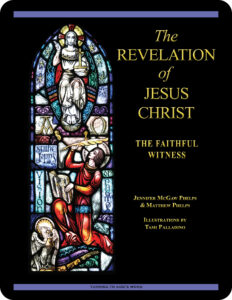 The Revelation of Jesus Christ:
The Revelation of Jesus Christ:
The Faithful Witness
Lesson 23 And Behold, I Am Coming Soon
the book of Revelation 22:1–21
Revised Standard Version Catholic Edition (RSVCE)*
New American Bible Revised Edition (NABRE)*
Catechism of the Catholic Church
Rosarium Virginis Mariae (Rosary of the Virgin Mary)
ex libris (in our library)
glossary for the book of Revelation
cross references in the book of Revelation
chapter-by-chapter review page
This material coordinates with Lesson 23 on pages 140–145 in The Revelation of Jesus Christ: The Faithful Witness.
“Great and wonderful are your deeds, O Lord God the Almighty! Just and true are your ways,
O King of the ages! Who shall not fear and glorify your name, O Lord? For you alone are holy.
All nations shall come and worship you, for your judgments have been revealed.”
—the book of Revelation 15:3–4
welcome to our in-depth study of the book of Revelation
We invite groups and individuals to check out the sample first lesson and video from this 23-lesson Turning to God’s Word Catholic Bible study. Our online pages link
link  to the free lesson videos, a glossary, cross references in the biblical text, and a chapter-by-chapter review page—and they also include illustrations, maps, additional commentary, and prayers based on the primary Scripture in each lesson. The Revelation of Jesus Christ: The Faithful Witness has been granted an imprimatur. The study may be purchased from our website shop. If you have a Bible-related question or comment, click on the “ask us your question” or “what do you think” button on any study page.
to the free lesson videos, a glossary, cross references in the biblical text, and a chapter-by-chapter review page—and they also include illustrations, maps, additional commentary, and prayers based on the primary Scripture in each lesson. The Revelation of Jesus Christ: The Faithful Witness has been granted an imprimatur. The study may be purchased from our website shop. If you have a Bible-related question or comment, click on the “ask us your question” or “what do you think” button on any study page.
open with prayer
It’s always wise to begin any Bible study with prayer, whether reading the Scriptures alone or meeting with others in a discussion study group. You can pray using your own words or use one of the opening prayers on our website. We especially like the following:
Lord Jesus, you promised to send your Holy Spirit
to teach us all things.
As we read and study your word today,
allow it to touch our hearts and change our lives. Amen.
let’s review—the book of Revelation 21:1–27
In Lesson 22 I Saw a New Heaven & a New Earth, John sees two new realms. The first heaven and the first earth have passed away, and the sea is no more. The holy city, new Jerusalem, comes down from heaven adorned as bride. A voice from the throne announces that the dwelling of God is with men. An angel shows the author the new Jerusalem, which is described in terms indicating how precious it is. There’s no Temple in the city, nor any need for sun or moon. The city’s gates never close. Nothing unclean is allowed to enter, only those whose names are written in the Lamb’s book of life.
we’re still asking—just how soon is soon?
Because we don’t have any idea what time frame Jesus is 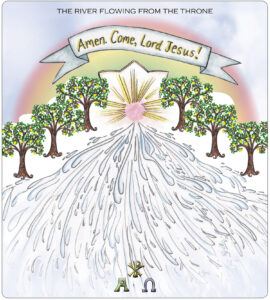 referring to when he says in the book of Revelation that he’s coming “soon,” the only sane approach for believers is to take Jesus at his word and live as though his idea of soon is the same as our
referring to when he says in the book of Revelation that he’s coming “soon,” the only sane approach for believers is to take Jesus at his word and live as though his idea of soon is the same as our 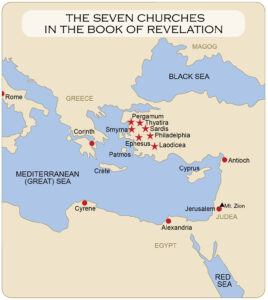 own. In other words, we should try to live in such a way that if Jesus were to show up in the next five minutes, we’d be as prepared as possible. This way of thinking gave strength to early Christians; 2,000 years later it still can provide strength to Christians. When we think about the complexity of the images used by the author of the book of Revelation, we experience little wonder that the apocalyptic vision ends with a divine threat aimed at anyone who attempts to change what’s been written. We’ve already been urged to use caution in interpreting the meaning of several specific images. Click on the image (above right) to enlarge Turning to God’s Word co-founder Tami Palladino’s illustration, which is on page 145 of The Revelation of Jesus Christ: The Faithful Witness. The map locating the churches that receive letters from Jesus is on page 143 and elsewhere in the study book; the image can be enlarged by clicking on it.
own. In other words, we should try to live in such a way that if Jesus were to show up in the next five minutes, we’d be as prepared as possible. This way of thinking gave strength to early Christians; 2,000 years later it still can provide strength to Christians. When we think about the complexity of the images used by the author of the book of Revelation, we experience little wonder that the apocalyptic vision ends with a divine threat aimed at anyone who attempts to change what’s been written. We’ve already been urged to use caution in interpreting the meaning of several specific images. Click on the image (above right) to enlarge Turning to God’s Word co-founder Tami Palladino’s illustration, which is on page 145 of The Revelation of Jesus Christ: The Faithful Witness. The map locating the churches that receive letters from Jesus is on page 143 and elsewhere in the study book; the image can be enlarged by clicking on it.
 why we lose a sense of urgency about our faith (35:07)
why we lose a sense of urgency about our faith (35:07)
In the twenty-second chapter in the book of Revelation, the author wraps up his  vision. In the video for this final lesson, Turning to God’s Word author Matthew Phelps suggests that a key takeaway thought for the book of Revelation is that prophecy has multiple components and facets across all of time. The Bible not only is about what’s occurred in history and about Jesus’ fulfillment of Old Testament prophecy, it also points toward events that are coming at the culmination of time. What this tells Christians is that we still have things to do in connection with our faith. It’s important not to view Jesus as an end point. Urgency is an essential element of our faith. We’re
vision. In the video for this final lesson, Turning to God’s Word author Matthew Phelps suggests that a key takeaway thought for the book of Revelation is that prophecy has multiple components and facets across all of time. The Bible not only is about what’s occurred in history and about Jesus’ fulfillment of Old Testament prophecy, it also points toward events that are coming at the culmination of time. What this tells Christians is that we still have things to do in connection with our faith. It’s important not to view Jesus as an end point. Urgency is an essential element of our faith. We’re  going somewhere, and what we do with this time we’ve been given determines how we’ll spend eternity. Everything in the Bible points forward to our destination. The book of Revelation makes the workings of the devil clear; we need to understand that we damn ourselves by our actions, and the devil’s lies are intended to pull us away from worship of God.
going somewhere, and what we do with this time we’ve been given determines how we’ll spend eternity. Everything in the Bible points forward to our destination. The book of Revelation makes the workings of the devil clear; we need to understand that we damn ourselves by our actions, and the devil’s lies are intended to pull us away from worship of God.
The Scripture ranges for the videos that accompany this Catholic Bible study match the Scripture ranges for the sets of questions in The Revelation of Jesus Christ: The Faithful Witness. You can follow along with the video overview as Turning to God’s Word author Matthew Phelps discusses Lesson 23, “And Behold, I Am Coming Soon,” on pages 140–145 in the study book.
practice some common sense
The book of Revelation underscores our need to carry with us a common-sense attitude whenever we read Scripture. If we don’t understand the word of God, that doesn’t mean there’s something wrong with the Bible. Instead, that’s an indication we need to pray and meditate more. There are many mysterious passages throughout the Bible, and it would be an arrogant person indeed who assumed to understand the word of God in its entirety. At the same time, the Scriptures are written for ordinary people, not scholars. Ordinary people—and all of us are ordinary in God’s eyes—can benefit from reading and praying about the Bible.
don’t be cavalier about the book of Revelation
The caution issued by the author of the book of Revelation isn’t intended to discourage us from reading the Scriptures. It’s to prevent us from treating difficult passages in a cavalier fashion and assuming that we know more than the divine author. The Church’s test of whether an interpretation is permissible rests on whether it’s in line with the rest of the Scriptures and with Church teaching. Any commentary that suggests the author’s meaning is restricted to a certain time in the past and therefore not relevant to us today is constructed on thin ice. Any suggestion that the apocalyptic vision of the book of Revelation isn’t “real” because it describes a vision is missing the underlying truth of its images.
the popes inspire us—the sacrament of Baptism renews the world
“Living Water” on page 142 of The Revelation of Jesus Christ: The Faithful Witness is from a n audience in which Pope Benedict XVI taught about the link between the sacrament of Baptism and the living water referred to throughout the Bible. In particular, Pope Benedict XVI connects the river of living water in the twenty-second chapter in the book of Revelation to Jesus’ amazing promise in the Gospel According to John 7:38: “He who believes in me, as the Scripture has said, ‘Out of his heart shall flow rivers of living water’.” According to the Holy Father, this means that in Baptism, the Lord makes us not only persons of light but also sources from which living water bursts forth. Consider how your faith in Jesus has led to a renewal of faith in the world around you. How does Christians’ faithfulness to their Baptismal promises bring about a renewal in life? In what ways is the image of a river a fitting description of Baptism? In what ways is it a fitting description of the thing that links humanity to the source of eternal life?
n audience in which Pope Benedict XVI taught about the link between the sacrament of Baptism and the living water referred to throughout the Bible. In particular, Pope Benedict XVI connects the river of living water in the twenty-second chapter in the book of Revelation to Jesus’ amazing promise in the Gospel According to John 7:38: “He who believes in me, as the Scripture has said, ‘Out of his heart shall flow rivers of living water’.” According to the Holy Father, this means that in Baptism, the Lord makes us not only persons of light but also sources from which living water bursts forth. Consider how your faith in Jesus has led to a renewal of faith in the world around you. How does Christians’ faithfulness to their Baptismal promises bring about a renewal in life? In what ways is the image of a river a fitting description of Baptism? In what ways is it a fitting description of the thing that links humanity to the source of eternal life?
WHAT DO YOU THINK about this final angel?
The identity of the angel speaking in the twenty-second chapter in the book of Revelation poses a special challenge. Throughout the book we’ve seen Jesus Christ represented as an angel, and in the book of Revelation 22:7 and 22:12, this angel says words that we’d expect only to come from Christ: “And behold, I am coming soon.” At the same time, in the book of Revelation 22:8-9, the angel strictly instructs John not to worship him but to reserve that honor for God alone.
Occasionally our initial ideas about the meaning of Scripture, though not well thought out, are nevertheless correct. Most of us instinctively understand the gist of what a particular passage means because we’ve been brought up with a Christian mindset. This is especially true of Jesus’ parables in the Gospels. Almost all Christians get the points that Jesus is trying to make. It’s only when we start to examine the parables more closely that we encounter difficulties in trying to make every detail fit. Something similar is at play in the twenty-second chapter in the book of Revelation.
 ? Who did you initially assume was speaking about coming soon in the book of Revelation 22:7 and 22:12?
? Who did you initially assume was speaking about coming soon in the book of Revelation 22:7 and 22:12?
? What thinking was behind that immediate assumption?
? Consider whether you still believe that your instinctive understanding was correct. What evidence in the text supports your assumption?
? What evidence contradicts it?
? Refer to the book of Revelation 22:16: “I Jesus have sent my angel to you with this testimony for the churches.” This verse very clearly is being spoken by Jesus. What does Jesus have to say about the angel who’s been communicating with John?
? What explanation can you suggest that might clarify who’s speaking to John in the various verses in the twenty-second chapter in the book of Revelation?
? Consider whether information in the twenty-second chapter causes you to rethink decisions about previous mentions of an angel in the book of Revelation.
read the Catechism—let’s think more about the collapse of time
One thing that makes the book of Revelation so difficult to follow is the way that the author treats time. Our reliance on linear thinking in terms of past, present, and future makes it almost impossible for us to even imagine getting rid of chronology. The Church teaches, however, that linear thinking in regard to time has no place in understanding Christ’s Paschal mystery. This complex theological idea is perhaps explained most clearly in paragraph 1085 in the Catechism of the Catholic Church:
 1085 In the liturgy of the Church, it is principally his own Paschal mystery that Christ signifies and makes present. During his earthly life Jesus announced his Paschal mystery by his teaching and anticipated it by his actions. When his Hour comes, he lives out the unique event of history which does not pass away: Jesus dies, is buried, rises from the dead, and is seated at the right hand of the Father “once for all.” His Paschal mystery is a real event that occurred in our history, but it is unique: all other historical events happen once, and then they pass away, swallowed up in the past. The Paschal mystery of Christ, by contrast, cannot remain only in the past, because by his death he destroyed death, and all that Christ is—all that he did and suffered for all men—participates in the divine eternity, and so transcends all times while being made present in them all. The event of the Cross and Resurrection abides and draws everything toward life.
1085 In the liturgy of the Church, it is principally his own Paschal mystery that Christ signifies and makes present. During his earthly life Jesus announced his Paschal mystery by his teaching and anticipated it by his actions. When his Hour comes, he lives out the unique event of history which does not pass away: Jesus dies, is buried, rises from the dead, and is seated at the right hand of the Father “once for all.” His Paschal mystery is a real event that occurred in our history, but it is unique: all other historical events happen once, and then they pass away, swallowed up in the past. The Paschal mystery of Christ, by contrast, cannot remain only in the past, because by his death he destroyed death, and all that Christ is—all that he did and suffered for all men—participates in the divine eternity, and so transcends all times while being made present in them all. The event of the Cross and Resurrection abides and draws everything toward life.
we can pray for greater understanding
We as Christians definitely should be reading the Scriptures. We should expect to encounter perplexing and confusing passages. When we do, we should take time to reread them more carefully, and to ask the Holy Spirit to guide us in applying them to our own lives. Sometimes God immediately provides answers to our questions, but in other instances it may take days, weeks, or even years. This surely isn’t because God doesn’t want us to understand. More likely it’s because we aren’t yet spiritually mature enough. In this regard, praying for understanding (one of the gifts of the Holy Spirit) is equivalent to begging God to help us grow spiritually. It’s a prayer that’s based on our faith—trust—in God.
 parousia—you could look it up in our archives
parousia—you could look it up in our archives
Christianity is concerned with two arrivals of Jesus Christ—the Incarnation, marked by his birth and celebrated at Advent, and the Second Coming, described by the Greek word “parousia.“ Lost in Translation is an online column in which Turning to God’s Word author Matthew Phelps helps readers connect with ideas expressed in the original languages of the Scriptures. New Lost in Translation entries are posted on Mondays, and past entries are archived on our website. Contact us if you’d like to receive Lost in Translation by email every week.
it’s about time: a reflection
The following meditation on the book of Revelation is by German theologian and priest Romano Guardini, who died in 1968.
The apocalyptical is that which reveals temporality’s [time’s] true face when it has been unmasked by the eternal. It was given to St. John to behold this. No pleasurable favor, this gift of the visionary eye. He who has it no longer can look at the things of existence without trembling at the sight of the hair by which they hang. He lives under the awful pressure of constant uncertainty. Nothing is safe. The borders between time and eternity melt away. From all sides eternity’s overwhelming reality closes in upon him, mounting from the depths, plunging from the heights. For the visionary, life ceases to be peaceful and simple. He’s required to live under duress, that others may sense how things really stand with them; that they may not only learn that this or that is to take place—still less the futile details of the time and circumstances—but that they may possess the essential knowledge of what all existence undergoes at the approach of the eternal. Only he reads the Apocalypse properly who leaves it with some sense of this.
ex libris—what happens to time at the end of time?
If you’re fascinated by the ideas about the end of time presented in the book of Revelation and like 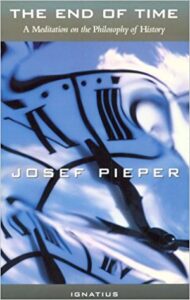 reading about philosophy and theology, The End of Time: A Meditation on the Philosophy of History by Josef Pieper might interest you. Pieper, a Catholic philosopher considered by many scholars to be among the most brilliant
reading about philosophy and theology, The End of Time: A Meditation on the Philosophy of History by Josef Pieper might interest you. Pieper, a Catholic philosopher considered by many scholars to be among the most brilliant  commentators on the thought of St. Thomas Aquinas, wrote The End of Time in 1954. As philosophical and theological writing goes, it’s rather more easily understandable than most such works—but that isn’t saying a lot. The content is well worth the effort if you’re the kind of person who has the patience to persevere. Expect the occasional need to refer to a dictionary. Pieper’s comments about our modern age as it relates to the end of time make frequent reference to the book of Revelation, and they’re in line with the Catholic interpretation presented in The Revelation of Jesus Christ: The Faithful Witness. Pieper concludes his work with a heavy emphasis on the importance of witness, which he calls “blood-testimony.” The witness of blood-testimony appears throughout the book of Revelation. What specific instances do you recall from this Catholic Bible study? For more information and to read an excerpt of The End of Time: A Meditation on the Philosophy of History, visit ex libris—main bookshelf.
commentators on the thought of St. Thomas Aquinas, wrote The End of Time in 1954. As philosophical and theological writing goes, it’s rather more easily understandable than most such works—but that isn’t saying a lot. The content is well worth the effort if you’re the kind of person who has the patience to persevere. Expect the occasional need to refer to a dictionary. Pieper’s comments about our modern age as it relates to the end of time make frequent reference to the book of Revelation, and they’re in line with the Catholic interpretation presented in The Revelation of Jesus Christ: The Faithful Witness. Pieper concludes his work with a heavy emphasis on the importance of witness, which he calls “blood-testimony.” The witness of blood-testimony appears throughout the book of Revelation. What specific instances do you recall from this Catholic Bible study? For more information and to read an excerpt of The End of Time: A Meditation on the Philosophy of History, visit ex libris—main bookshelf.
consider revisiting this study sometime
In addition to the lessons, illustrations, videos, and online study pages designed to help in your study of the book of Revelation, The Revelation of Jesus Christ: The Faithful Witness contains features to refresh 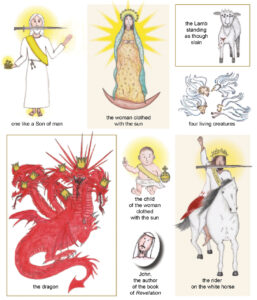 your memory about details in the study. Few of us can recall everything learned over a long course of study. It can even be fun to go back to the Scriptures and the textbook after we have a better idea of where the author of the book of Revelation is taking us. Helpful features include the Index of Citations beginning on page 146, the Topical Index on pages 151-154, and “Numbers in Revelation” on pages 156 and 157, a chart that briefly explains the symbolism of the numbers used throughout the book of Revelation. The final page 158, “Who’s Who in Revelation,” provides a visual reminder of some of the main characters in this apocalyptic vision. (Click to enlarge the computer image [right]). The illustrations paired with the lessons can jog our memories about important details in the biblical text, and the videos and online study pages related to the lessons are free on our website.
your memory about details in the study. Few of us can recall everything learned over a long course of study. It can even be fun to go back to the Scriptures and the textbook after we have a better idea of where the author of the book of Revelation is taking us. Helpful features include the Index of Citations beginning on page 146, the Topical Index on pages 151-154, and “Numbers in Revelation” on pages 156 and 157, a chart that briefly explains the symbolism of the numbers used throughout the book of Revelation. The final page 158, “Who’s Who in Revelation,” provides a visual reminder of some of the main characters in this apocalyptic vision. (Click to enlarge the computer image [right]). The illustrations paired with the lessons can jog our memories about important details in the biblical text, and the videos and online study pages related to the lessons are free on our website.
one final review—the book of Revelation 22:1–21
The key points to remember from Lesson 23, “And Behold, I Am Coming Soon,” involve the conclusion of John’s vision of heaven. The river of the water of life flows from the throne of God and the Lamb in the middle of the city. John assures us that his vision is true and that Jesus is coming soon. John is admonished when he attempts to worship the angel showing him the new Jerusalem. The angel tells John that they are fellow servants. A warning is issued that no one should add or subtract from the words written in the book of Revelation. The final book of the New Testament closes with this prayer: “Amen. Come, Lord Jesus! The grace of the Lord Jesus be with all the saints. Amen.”
the final Comforting Mystery of the Rosary
As an aside, we’ve been tracking ways that the Comforting Mysteries of the Rosary align with our study  of The Revelation of Jesus Christ: The Faithful Witness. In the final lesson we find evidence of the last of these Mysteries, which often are used in private prayer by Catholics living in German-speaking countries. The fifth Comforting Mystery, “Jesus will complete everything,” consists of a promise, the fulfillment of which is prophesied at the end of the book of
of The Revelation of Jesus Christ: The Faithful Witness. In the final lesson we find evidence of the last of these Mysteries, which often are used in private prayer by Catholics living in German-speaking countries. The fifth Comforting Mystery, “Jesus will complete everything,” consists of a promise, the fulfillment of which is prophesied at the end of the book of  Revelation. Learn more about the traditional Mysteries of the Rosary in Scripture & the Rosary: New Testament Mysteries, Old Testament Parallels. Free digital lessons from that Bible study are available on our website on a rotating basis throughout the liturgical year.
Revelation. Learn more about the traditional Mysteries of the Rosary in Scripture & the Rosary: New Testament Mysteries, Old Testament Parallels. Free digital lessons from that Bible study are available on our website on a rotating basis throughout the liturgical year.
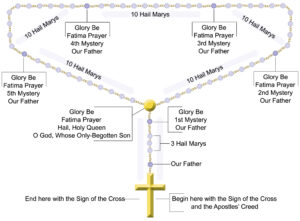 pray the traditional mysteries of the Rosary
pray the traditional mysteries of the Rosary
We invite you to pray the Rosary along with Turning to God’s Word co-founder Tami Palladino and her daughter Anne Marie. The prayers can be found at how to pray the Rosary, along with Tami and Anne Marie’s videos of each of the traditional Rosary Mysteries—the Joyful, Sorrowful, Glorious, and Luminous. Click on the diagram (right) to link to their how-to video. Visit the study directory of our most popular Catholic Bible study, Scripture & the Rosary: New Testament Mysteries, Old Testament Parallels, for more information about the Rosary and access to free online lessons.
WHAT DO YOU THINK about this Catholic Bible study?
Send us an email to share your experience studying The Revelation of Jesus Christ: The Faithful Witness. We’d love to hear from you.
? Which passage from the book of Revelation did you find to be the most relevant in your life, and why?
 ? How have your ideas about the Catholic faith changed as a result of studying The Revelation of Jesus Christ: The Faithful Witness?
? How have your ideas about the Catholic faith changed as a result of studying The Revelation of Jesus Christ: The Faithful Witness?
? What’s one unexpected way that this Bible study has touched your life?
? What’s something you’ve learned from studying The Revelation of Jesus Christ: The Faithful Witness that you’d like to share with others?
? To whom would you like to recommend The Revelation of Jesus Christ: The Faithful Witness?
? What book of the Bible would you like to study next, and why?
the best Catholic commentary about Scripture
 To find out more about how Church teaching is supported by Scripture passages in The Revelation of Jesus Christ: The Faithful Witness, check out the Index of Citations in the Catechism of the Catholic Church. Links to the primary Scripture passages in the lesson (Revised Standard Version Catholic Edition [RSVCE*]) and relevant paragraphs in the Catechism are provided here. Not every passage in the biblical text for this Catholic Bible study is referenced in a Catechism paragraph, however.
To find out more about how Church teaching is supported by Scripture passages in The Revelation of Jesus Christ: The Faithful Witness, check out the Index of Citations in the Catechism of the Catholic Church. Links to the primary Scripture passages in the lesson (Revised Standard Version Catholic Edition [RSVCE*]) and relevant paragraphs in the Catechism are provided here. Not every passage in the biblical text for this Catholic Bible study is referenced in a Catechism paragraph, however.
the book of Revelation 22:1—paragraph 1137
the book of Revelation 22:4—paragraph 1023
the book of Revelation 22:5—paragraph 1029
the book of Revelation 22:15—paragraph 1470
the book of Revelation 22:16—paragraph 528
the book of Revelation 22:17—paragraphs 524, 671, 694, 757, 796, 1130, 2550, 2853
the book of Revelation 22:20—paragraphs 1130, 1403, 2853
the book of Revelation 22:21—paragraph 1061
ways our glossary might prove helpful
In addition to providing extra information about geographical locations, our glossary also points out persons and places mentioned in the biblical text under multiple names or spellings. If you can remember a name but aren’t sure in which lesson it shows up, you can find it in the glossary, which lists every proper noun in the primary biblical text for The Revelation of Jesus Christ: The Faithful Witness.
persons and places mentioned in the biblical text under multiple names or spellings. If you can remember a name but aren’t sure in which lesson it shows up, you can find it in the glossary, which lists every proper noun in the primary biblical text for The Revelation of Jesus Christ: The Faithful Witness.
to learn more, read more Scripture
If you’re having difficulty with a passage of Scripture, it can be helpful to read the  cross references pertaining to it—but looking these up can take time. To make that easier, we’ve compiled the cross references from the Revised Standard Version Second Catholic Edition (RSV2CE)—the translation that we reprint in our study books. That list can be found at the top of every online study page, and it includes links to cross references in the primary biblical text for The Revelation of Jesus Christ: The Faithful Witness.
cross references pertaining to it—but looking these up can take time. To make that easier, we’ve compiled the cross references from the Revised Standard Version Second Catholic Edition (RSV2CE)—the translation that we reprint in our study books. That list can be found at the top of every online study page, and it includes links to cross references in the primary biblical text for The Revelation of Jesus Christ: The Faithful Witness.
review previous lessons
As we progress through the book of Revelation, the images become more complex, increasing the potential for confusion. To help participants  in our study keep track of what’s happening in the Scripture, we’ve prepared a chapter-by-chapter review of key events and images in the book of Revelation. A link can be found at the top of every online study page that accompanies The Revelation of Jesus Christ: The Faithful Witness.
in our study keep track of what’s happening in the Scripture, we’ve prepared a chapter-by-chapter review of key events and images in the book of Revelation. A link can be found at the top of every online study page that accompanies The Revelation of Jesus Christ: The Faithful Witness.
don’t forget about our indexes & extra online material

 If you’re trying to locate information about a specific Scripture passage, you can look it up in the index at the back of the study book or sample lesson. If you want to find a particular commentary, you can look up its title in the topics index. To learn more about another book of the Bible for which there’s a Turning to God’s Word study, visit the online study directories to read the commentaries and watch any accompanying videos. Finally, if you have a question or would like to make a comment about any of our studies, you can use one of the “ask us your question” or “what do you think” buttons to email our authors.
If you’re trying to locate information about a specific Scripture passage, you can look it up in the index at the back of the study book or sample lesson. If you want to find a particular commentary, you can look up its title in the topics index. To learn more about another book of the Bible for which there’s a Turning to God’s Word study, visit the online study directories to read the commentaries and watch any accompanying videos. Finally, if you have a question or would like to make a comment about any of our studies, you can use one of the “ask us your question” or “what do you think” buttons to email our authors.
ex libris—Church documents & books about religious topics
You can find links to magisterial documents referred to in Turning to God’s Word Catholic Bible studies  at ex libris—magisterial documents. This page includes a listing of significant recent encyclicals as well as a number of historical Church documents. Recommended books related to Scripture study can be found at ex libris—main bookshelf.
at ex libris—magisterial documents. This page includes a listing of significant recent encyclicals as well as a number of historical Church documents. Recommended books related to Scripture study can be found at ex libris—main bookshelf.
wondering how to pronounce some of these words?
The following link is to a reading from the New International Version (NIV) Bible. To listen, click on the audio icon above the printed text. Although not taken from the translations used in our study materials, the NIV reading provides an audio guide to pronunciation of words in this lesson’s primary biblical text. A close online version of the translation of the Bible used in Catholic liturgy in the United States as well as an audio guide for daily Mass readings for the current month can be found on the website of the United States Conference of Catholic Bishops (USCCB).
the book of Revelation 22:1–21 (NIV)
 close with Bible-based prayer related to this lesson
close with Bible-based prayer related to this lesson
Many of our Catholic study groups like to conclude their discussions with a prayer based on the scriptural focus of their lesson, and some participants include Scripture-specific prayer in their individual study. If you’re uncomfortable composing your own Bible-based prayers, you can follow our four easy steps. If you prefer, you can use the following short prayer based on this lesson’s text from the book of Revelation.
O merciful and loving God, whose every thought and action
are beyond the scope of our limited understanding,
grant us patience to persevere in our meditation and prayer,
confident that our inability to fully understand
everything written in Sacred Scripture
won’t hamper our ability to love and serve you.
We ask this in the name of your Son, Jesus Christ,
who’s made heaven a possible eternal destination
for all men and women who trust in his word. Amen.
Lesson 22 I Saw a New Heaven & a New Earth, the book of Revelation 21:1–27
you also may like our study of Scripture & the Rosary
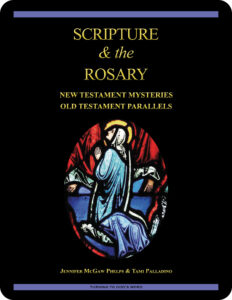 Scripture & the Rosary: New Testament Mysteries, Old Testament Parallels, a 26-lesson Catholic Bible study with an imprimatur, looks at the biblical foundations of the Rosary. The study includes lessons on Pope St. John Paul II’s Rosarium Virginis Mariae (Rosary of the Virgin Mary), the Apostles’ Creed, and the Luminous Mysteries as well as the original 15 Mysteries of the Rosary. Color photographs of stained glass windows depict key scenes in the lives of Jesus and Mary. Free digital lessons rotate throughout the year on our website.
Scripture & the Rosary: New Testament Mysteries, Old Testament Parallels, a 26-lesson Catholic Bible study with an imprimatur, looks at the biblical foundations of the Rosary. The study includes lessons on Pope St. John Paul II’s Rosarium Virginis Mariae (Rosary of the Virgin Mary), the Apostles’ Creed, and the Luminous Mysteries as well as the original 15 Mysteries of the Rosary. Color photographs of stained glass windows depict key scenes in the lives of Jesus and Mary. Free digital lessons rotate throughout the year on our website.
start a Turning to God’s Word Bible study
 Thank you for your interest in The Revelation of Jesus Christ: The Faithful Witness.
Thank you for your interest in The Revelation of Jesus Christ: The Faithful Witness.  Information about beginning a Turning to God’s Word Bible study can be found at start a Bible study. Tami, Matthew, and I are available to answer questions and offer support. Contact us if you’d like to start one of our studies or have your schedule listed with other TtGW study groups on our website. —Jennifer
Information about beginning a Turning to God’s Word Bible study can be found at start a Bible study. Tami, Matthew, and I are available to answer questions and offer support. Contact us if you’d like to start one of our studies or have your schedule listed with other TtGW study groups on our website. —Jennifer
*There are seven deuterocanonical books in the Old Testament—the Books of Tobit, Judith, Wisdom, Sirach, Baruch, and First and Second Maccabees, as well as some passages in the Books of Esther and Daniel. Protestants usually refer to these works as “apocryphal,” a word that means “outside the (Protestant) canon” because they’re excluded from most Protestant Bibles. The word “deuterocanonical” means “second canon”; Catholics use that word to refer to any section of the Catholic Old Testament for which there are no extant, or existing, Hebrew manuscripts. All of the deuterocanonical books appear in the Septuagint, the earliest remaining versions of which date to the 1st century B.C. This Greek translation of the Old Testament was in common use by Jews at the time of Jesus. Learn more by reading How Do Catholic & Protestant Bibles Differ?
Turning to God’s Word printed Bible studies use the 2006 Revised Standard Version Second Catholic Edition (RSV2CE) translation for all Scripture references except those to the Psalms, which are taken from The Abbey Psalms and Canticles, prepared by the Benedictine monks of Conception Abbey and published in 2020 by the United States Conference of Catholic Bishops (USCCB). All Scripture links for the online pages of The Revelation of Jesus Christ: The Faithful Witness are to the 1966 Revised Standard Version Catholic Edition (RSVCE) translation. The New International Version (NIV) audio recordings follow the same chapter and verse numbering as the RSV Catholic translations, but the NIV translation doesn’t include the deuterocanonical books and passages.
The 1966 RSVCE uses archaic pronouns and verb forms such as “thee,” “thou,” “didst” in the Psalms and in direct quotations attributed to God. The 2006 RSV2CE replaces these with more accessible English. The few significant translation changes in the RSV2CE include rendering almah as “virgin” in the Book of Isaiah 7:14 and restoring the term “begotten” in the Gospel According to John 3:16.
Numbering varies for some passages in this Bible study. Turning to God’s Word studies (print and digital) follow the numbering in the Revised Standard Version Catholic translations (RSV2CE and RSVCE). Discrepancies in the New American Bible Revised Edition (NABRE) are noted in the Index of Scripture Citations in the study book and the online sample.
 You can learn more about the Psalms by viewing a sample lesson from the Turning to God’s Word Catholic Bible study Sing a New Psalm: Communicating with God Through the Prayers of the Church—Volume I: Lauds & Vespers. The second part of that study, Sing a New Psalm: Communicating with God Through the Prayers of the Church—Volume II: Vigils, Day Prayer & Compline, is scheduled for publication in 2025. Some verse numbers may vary in different translations of the Psalms.
You can learn more about the Psalms by viewing a sample lesson from the Turning to God’s Word Catholic Bible study Sing a New Psalm: Communicating with God Through the Prayers of the Church—Volume I: Lauds & Vespers. The second part of that study, Sing a New Psalm: Communicating with God Through the Prayers of the Church—Volume II: Vigils, Day Prayer & Compline, is scheduled for publication in 2025. Some verse numbers may vary in different translations of the Psalms.
